MYCO | 1.1 Fungi & Tree of Life, 1.2 Brief History of Mycology
1/129
There's no tags or description
Looks like no tags are added yet.
Name | Mastery | Learn | Test | Matching | Spaced |
|---|
No study sessions yet.
130 Terms
T/F: Fungi are heterotrophic eukaryotes with chitinaceous cell walls capable of photosynthesis
FALSE
Fungi are heterotrophic eukaryotes with chitinaceous cell walls incapable of photosynthesis
Hetetrotrophic eukaryotes with chitinaceous cell walls incapable of photosynthesis
Fungi
Fungi in Latin means _, but it has become a stand-in term for all members of the group
mushroom
T/F: Most fungi form mushrooms
FALSE
Why were slime molds and water molds previously considered fungi?
Due to their filamentous structures suspected to be hyphae-like
Fungi belong to the crown eukaryote group, derived from the
Last eukaryotic common ancestor (LECA)
T/F: Fungi size can range from individual cells (e.g., yeasts) to multicellular organisms
TRUE
The largest living organism on earth is a _
monoclonal fungus
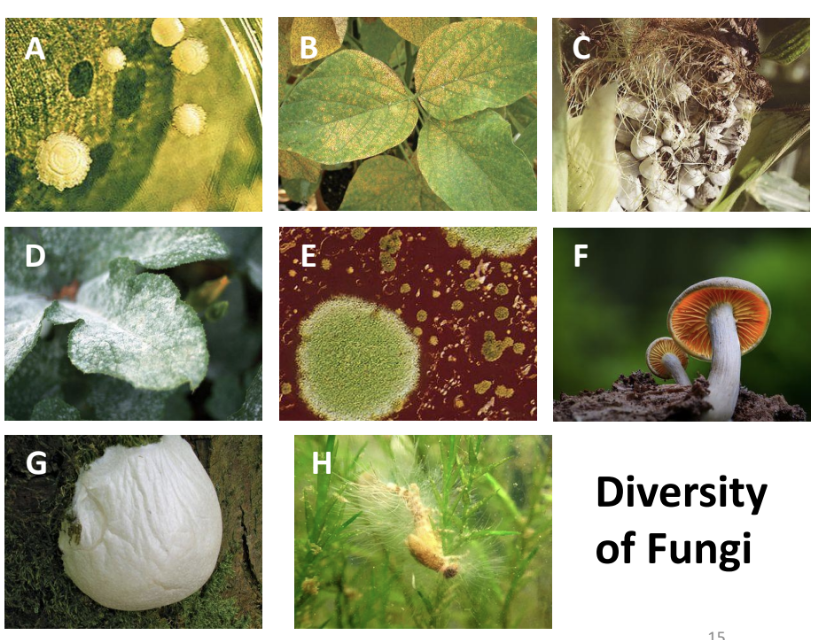
Fungi are a diverse group of eukaryotes that include, _ (6), forming a kingdom under domain Eukarya
A) Yeasts
B) Rusts
C) Smuts
D) Mildews
E) Molds
F) Mushrooms
2 basic forms of fungi
Hyphal (filamentous)
Yeast
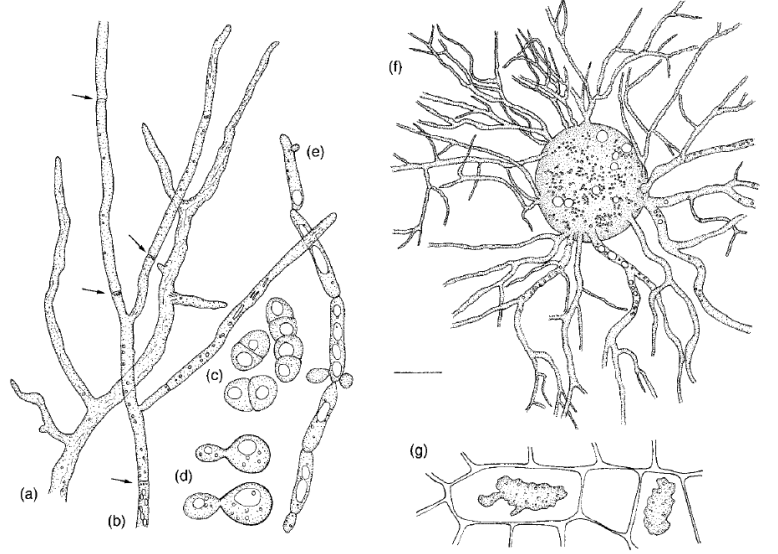
The evolutionary history of fungi reflects how they have been able to conquer many habitats through _
a diversity of forms
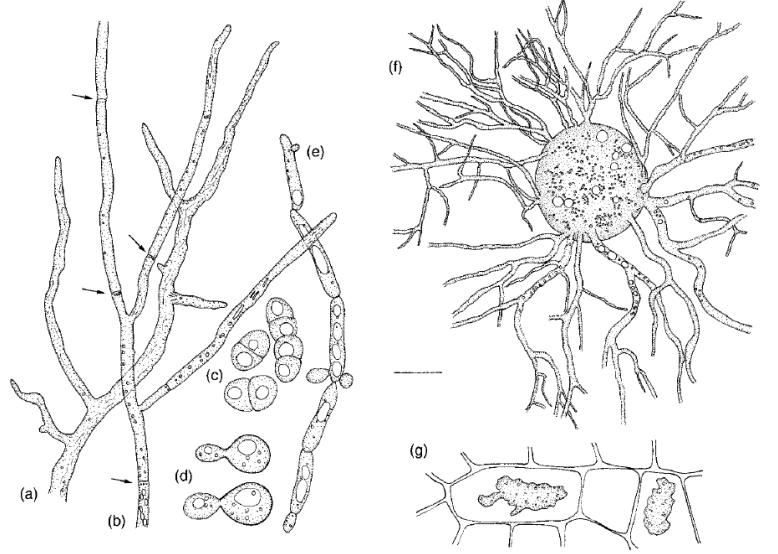
Various growth forms of fungi
Aseptate hypha of Mucormucedo

All fungi have a base _ form in terms of their ultrastructure
yeast or hyphal

Microscopic fungi consisting of solitary cells that reproduce by budding
e.g., _
Yeast
Yeast cells of Saccharomyces cerevisiae
Also called the filamentous or mold form of fungi
Long filaments = hyphae, which grow by apical (tip) extension
e.g.,
Hyphal form
Growing hypha of Aspergillus niger
T/F: Some fungi can alternate cell growth between yeast and filamentous forms, meaning they are dimorphic
TRUE
Yeasts are fungi because _
they possess features characterizing the Kingdom Fungi cesaf
Chitin in cell walls
Extracellular digestion
Saprophytic nutrition
Asexual reproduction
Food stored as glycogen
Several fungi grow as _, rather than as hyphae
budding uninucleate yeasts
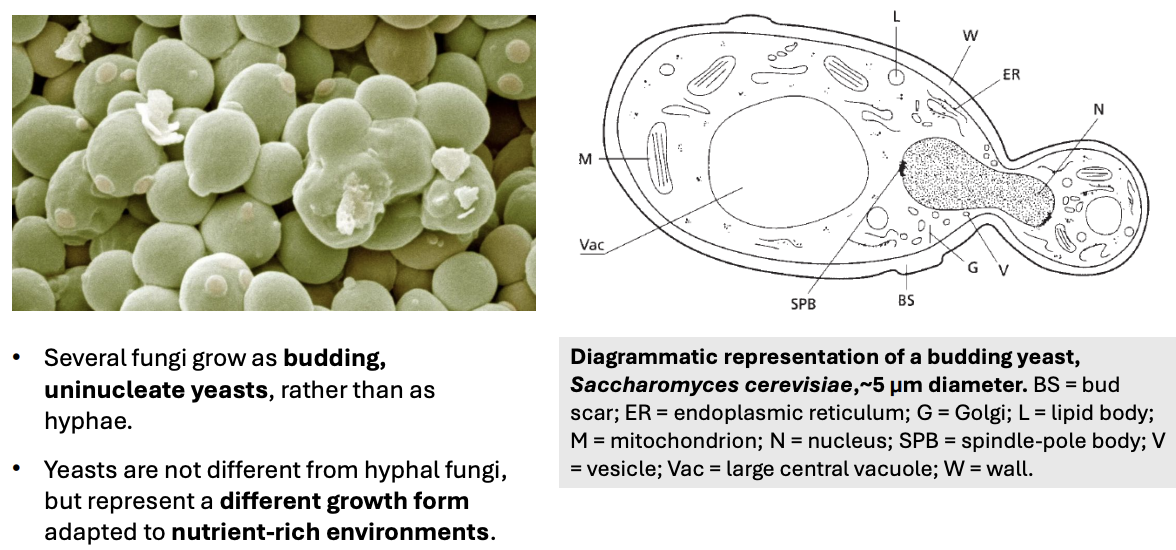
Yeasts are not different from hyphal fungi but represent a _
different growth form adapted to nutrient-rich environments

Fungus-like organisms such as _ (2) do not belong to kingdom Fungi but are often called fungi as well
G) Slime molds
H) Water molds
4 commonalities of members of Kingdom Fungi
hcec
Heterotrophic
Chitin in cell walls
Enzyme secretion
Cannot photosynthesize
T/F: Yeasts are not different from hyphal fungi but represent a different growth form adapted to nutrient-poor environments
FALSE
Yeasts are not different form hyphal fungi but represent a different growth form adapted to nutrient-rich environments
Fungi share a common protozoan ancestor with the _ they diverged from
animals
T/F: Choanoflagellates are classified under Kingdom Animalia
FALSE
Protista; Opisthokonta
T/F: All true fungi have a range of features that separate them from other organisms and serve to define the Kingdom Mycota (Eumycota)
TRUE
6 characteristic features of fungi
euhychi hehap rep
Possess common eukaryotic features
Membrane-bound nucleus with several chromosomes
Membrane-bound organelles
DNA with introns
Membranes with sterols
80S ribosomes
Cytoplasmic streaming
Composed of hyphal filaments with apical growth
Hyphae branch repeatedly behind their tips, giving rise to mycelial network (mycelium)
Some fungi (e.g., yeasts) are single-celled and grow by budding
Some are dimorphic
Unique cell wall
Little to no cellulose
Composed of chitin and glucans (glucose polymers) with associated proteins
pcsm
Plasma membrane = ergosterol + B-1,3-glucan synthase
Chitin
Sugar = B-1,6- and B-1,3-glucan
Mannoproteins = glycoproteins
Heterotrophic
Need pre-formed organic materials to survive
Since they cannot engulf food molecules, they absorb soluble nutrients
Enzyme secretion from hyphal tips is very common to degrade various materials (e.g., enzyme crystals in detergent)
Haploid nuclei
Major difference from other eukaryotes & fungal hyphae with several nuclei is their haploid genome in their fungal nucleus
Some fungi spend significant portion of their life cycle in haploid state (with haploid nuclei), i.e., 1 set of chromosomes
Some yeasts are diploid
Has major implications on fungal genetics
Mutations are immediately expressed since there are no masking effects of a second allele, as what happens in a diploid organism
Genetic adaptation and evolution would be more rapid
Reproduction (spores)
Can reproduce sexually and asexually
Reproduction typically uses spores, which are also used for dormancy and as tools for dispersion
Reproductive strategies of different taxa can be very unique
T/F: More often than not, eukaryotic cells are diploid
TRUE
Except haploid gametes (e.g., sperm & egg cells)
Implications to being a diploid organism vs. haploid organism
Diploid
Genetic diversity
Having 2 sets of chromosomes would allow for genetic recombination during meiosis; this shuffling of genetic material increases genetic diversity, which is crucial for adaptation and evolution in changing environments
Buffer against mutations (recessive alleles masking effect)
Having 2 sets of chromosomes would mean that deleterious mutations in 1 allele can be compensated by functional allele in the other, reducing likelihood of organisms expressing harmful traits and contributing to their overall fitness
Haploid
Reduced energy cost
Having only 1 set of chromosomes means having a smaller amount of genetic material to replicate, repair, and segregate during cell division, allowing for faster growth rate and reduced energy costs
Direct expression of mutation
All alleles are expressed since there is no second allele to mask the effects → immediate expression of deleterious/beneficial mutations
Fungal characteristic/feature
Need pre-formed organic materials to survive
Since they cannot engulf food molecules, they absorb soluble nutrients
Secretion of enzymes from their hyphal tips is a very common way to degrade various materials
Heterotrophic

Fungal enzymes are generally more stable than bacterial enzymes as detergent due to their _
heterotrophy, i.e., need to secrete substances to degrade materials
Fungal characteristic/feature
Hyphae branch repeatedly behind the tips, giving rise to mycelial network (mycelium)
But some fungi are single-celled and thus grow by budding, e.g., yeasts
Some are dimorphic
Hyphal filaments with apical growth
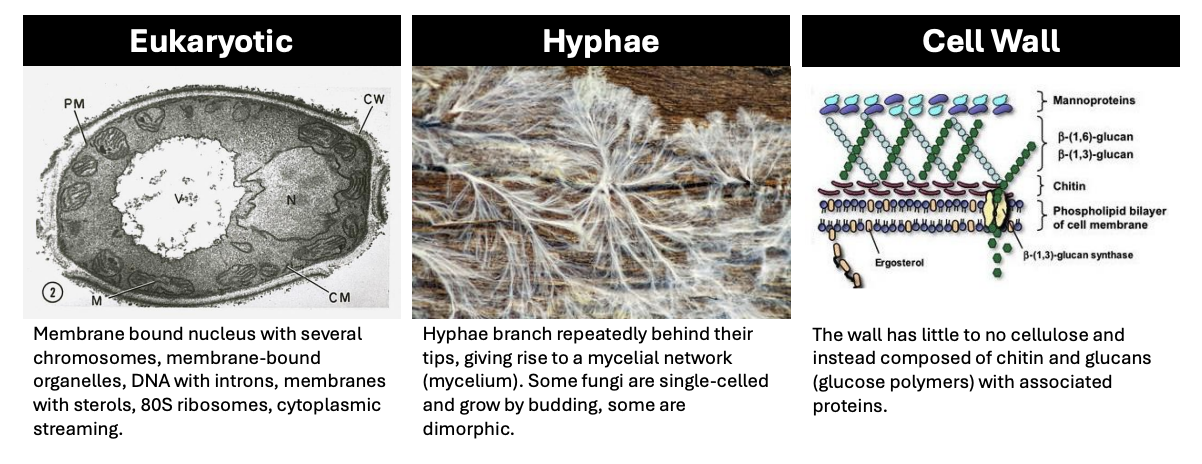
Fungal characteristic/feature
Can be a sexual or asexual process
_ typically uses spores, which are also used for dormancy and as tools for dispersion
_ strategies of different taxa can be very unique
Reproduction (spores)

Fungal characteristic/feature
Little to no cellulose
Has chitin and glucan (glucose polymers) with associated proteins instead
Composition pcsm
Plasma membrane with ergosterol, B-1,3-glucan synthase
Chitin
Sugars = B-1,3,- ; B-1,6- ; B-1,4-glucan
Mannoproteins = glycoproteins
Chitinaceous cell wall

T/F: All fungi have chitin in their cell wall
FALSE
There has recently been a fungus discovered not to have chitin but possess euhy hehaprep = fungus
Fungal characteristic/feature
Has
membrane-bound nucleus
membrane-bound organelles
DNA with introns (eukaryotic histones)
membranes with sterols
80S ribosomes
cytoplasmic streaming
Possess common eukaryotic features
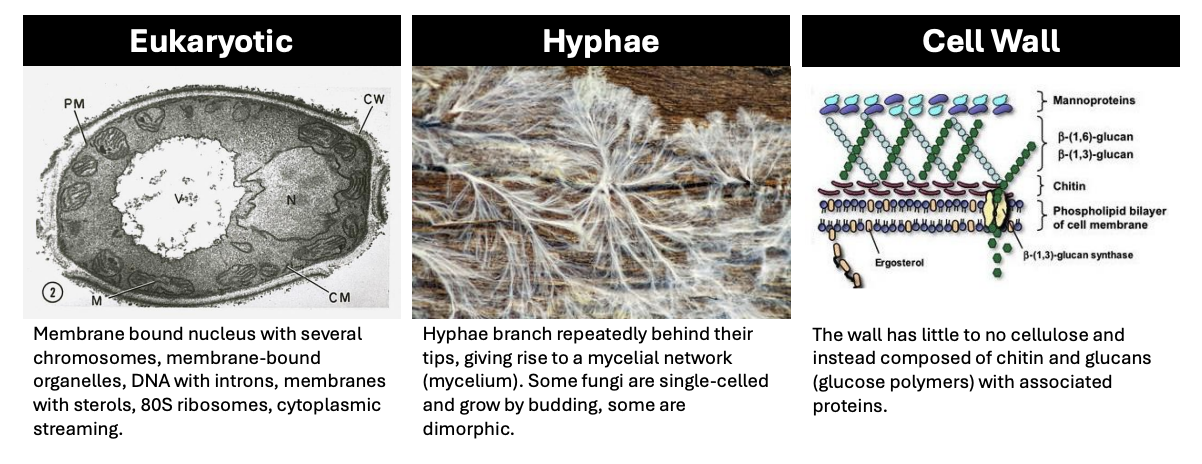
T/F: All fungi produce hyphae, even mushrooms.
FALSE
Yeasts are single-celled non-hyphal structures, but they possess euchi hehaprep = fungi
T/F: All yeasts cannot produce hyphae
FALSE
There are yeasts that can produce hyphae
Main structure fungi uses for growth and reproduction
Hyphae
T/F: Fungi includes phototrophic eukaryotes with rigid chitinaceous cell walls, forming single phylogenetic group
FALSE
Fungi includes nonphototrophic eukaryotes with rigid chitinaceous cell walls, forming single phylogenetic group
Fungal characteristic/feature
Major difference from other eukaryotes and fungal hyphae with several nuclei is their _
Some yeasts are diploid
Have implications on fungal genetics, including _
Haploid genome in the fungal nucleus
Mutations are immediately expressed, given that there would be no masking effects of a second allele, as what happens in a diploid organism
Genetic adaptations and evolutions would also be more rapid bc you’re dealing with only 1 set of chromosomes
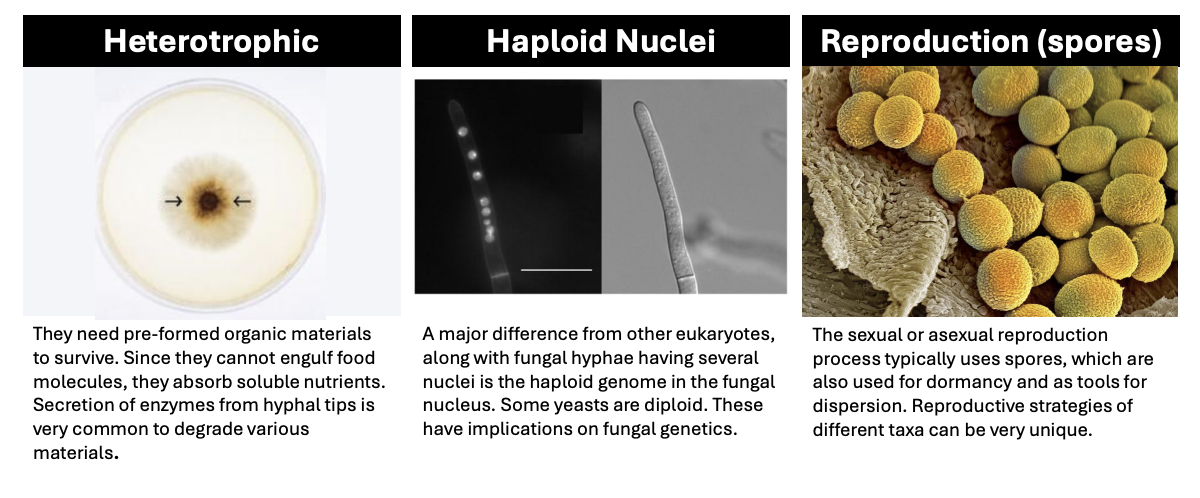
T/F: Fungi reproduce primarily through spores
TRUE
T/F: All yeasts are haploid
FALSE
Some yeasts are diploid
Fungi share a common _ ancestor with the animals they diverged from
protozoan
Oldest fungi fossils are _ yo, but there is recent evidence of fungi-like microorganisms present in a 2.4 BYO _ (Bengtson et al. 2017)
460 - 455 myo
Basalt stone (with filamentous hyphae-like structures)
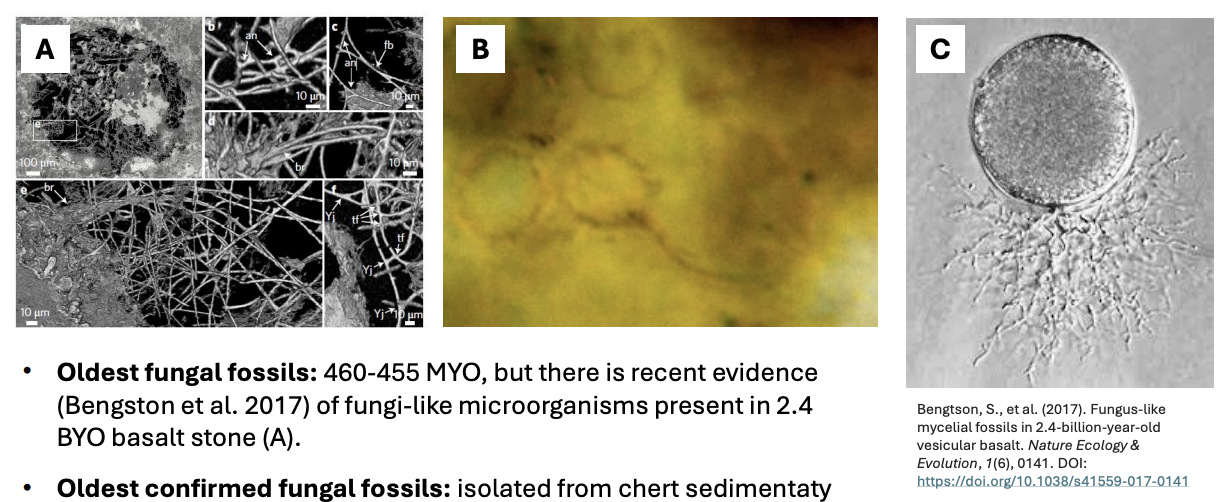
T/F: No other living thing produces hyphae other than fungi
TRUE
But slime and water molds have filamentous hyphae-like structure
Oldest confirmed fungal fossils isolated from _ are similar to the modern-day _, which have flagella (water-dependence)
Chert (dark opaque rock consisting of silica) sedimentary rock Modern-day Chytridiomycota
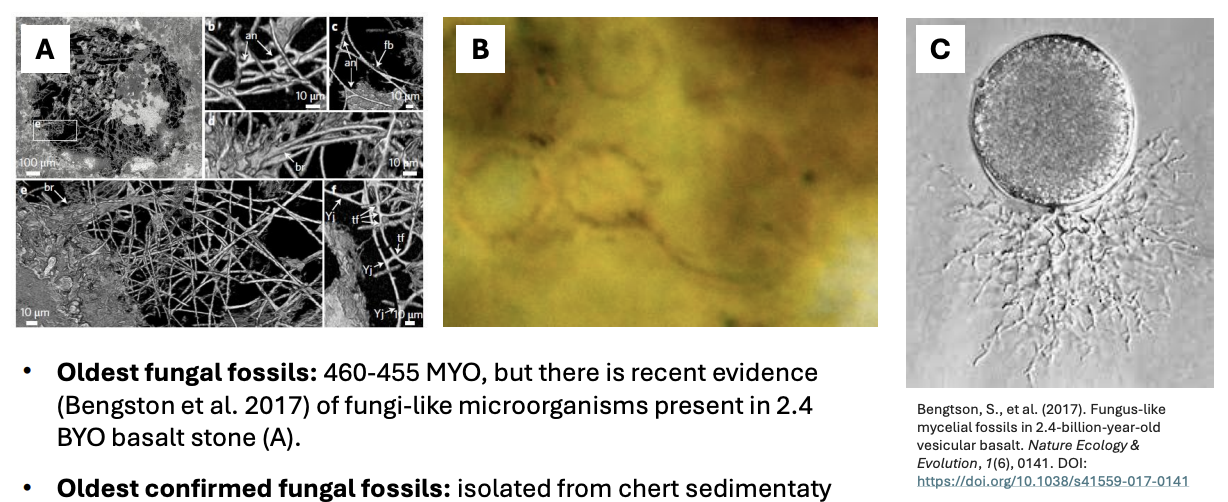
Most basal group of fungi (oldest, most unchanged)
Chytridiomycota

Hallmark feature of Chytridiomycota
Flagella bc life evolved from water and thus need to utilize water medium to grow
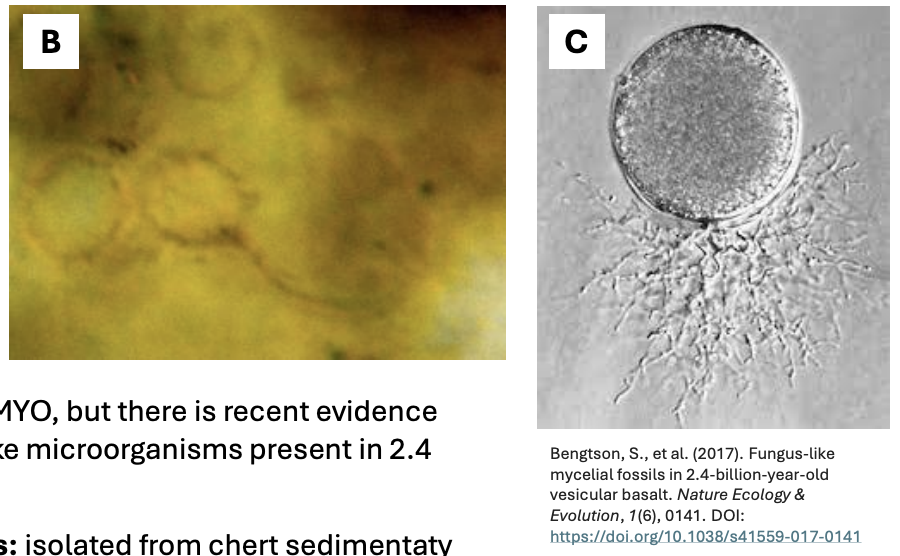
T/F: Some fungi still have flagella; most don’t have, but there are spores that have flagella
TRUE
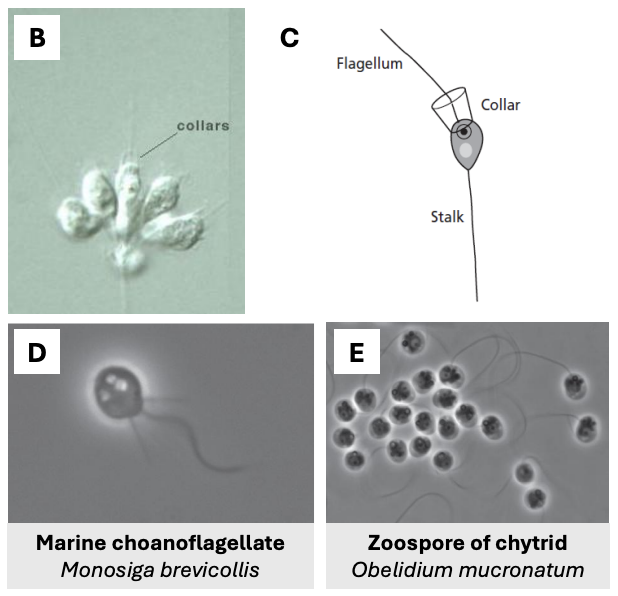
Stalked unicellular organism with collars (where collar is, there’s flagellum)
Choanoflagellates
_ anchors choanoflagellate, while _ is responsible for their motion
Stalk
Singular flagellum
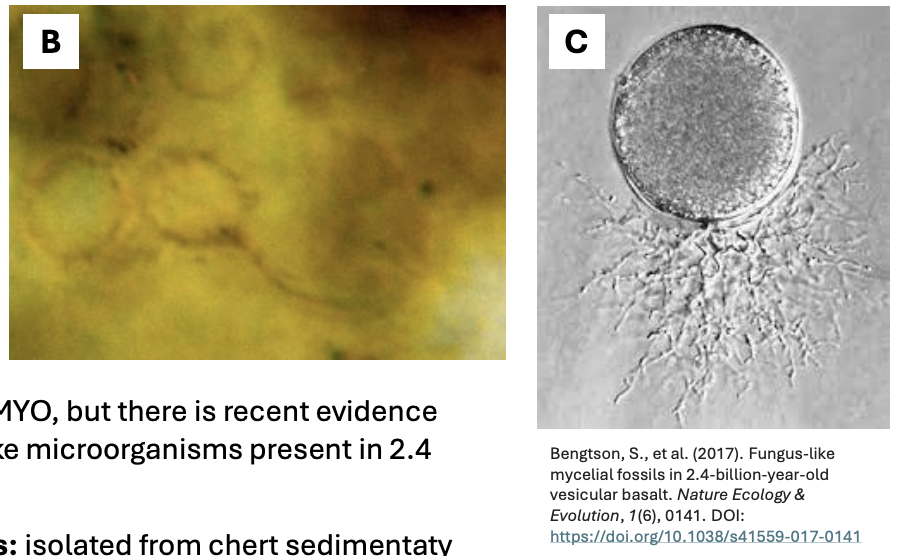

Abundant evidence of fossil fungi associated with primitive land plants suggest _ due to fungi’s ability to enhance the uptake of mineral nutrients + water
coevolution
In present times, almost _% of living land plants have some kind of fungi associated with them to aid their metabolism and other activities
90%
Fungi, while classified as plants for a long time, are closer to animals and could have a common protozoan ancestor from the _ group, as evidenced by structure
Choanoflagellate
Marine choanoflagellate = Monosiga brevicolis
Zoospore of chytrid = Obelidium mucronatum
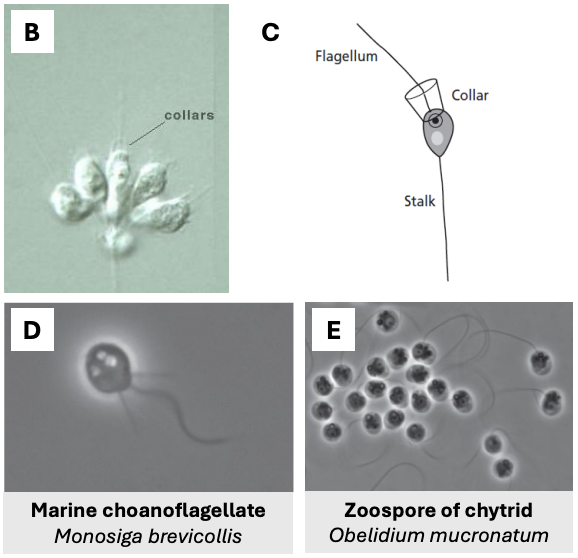
Egyptians consistently depicted fungi in _
hieroglyphics

Documentation of fungi in Egypt may be dated back to _
4500 BC

Rumor has it that Egyptians used fungi for rituals, specifically they used _ during their secret rites to attain an altered state and ascend to the realm of the gods
psychoactive mushrooms
What was true, however, is that Egyptians were among the earliest civilizations to realize the importance of _ for making bread, wine, and beer central to Egyptian culture (Ramses II)
yeasts
Biblically, the Israelites consume unleavened bread for festivals because these are considered _
“clean,” i.e., do not use any animals or yeasts and do not rise
What was true, however, is that Egyptians were among the earliest people to realize the importance of yeasts for making _ central to Egyptian culture
bread, wine, beer (1% or lower; now 6-10%)
T/F: Mycological illustrations have a rich history
TRUE

Oldest known mycological illustration was by the _ buried in 79 AD (eruption of Mt. Vesuvius)
Romans in Pompeii (fresco)

1st published fungal illustration was in a materia medica titled _
Ortus Sanitatis. De Herbis et Plantis […] in 1491

3 issues with historical mycological illustrations
npo
No fresh specimens
Primitive painting
Overactive imaginations
The origin of mushrooms fascinated the early human civilizations hwo believed in their _
spontaneous generation
Greeks, i.e., Pliny (23-79 AD), widely believed that truffles originated from a fluid generated by _
thunder mixing with heat, penetrating earth
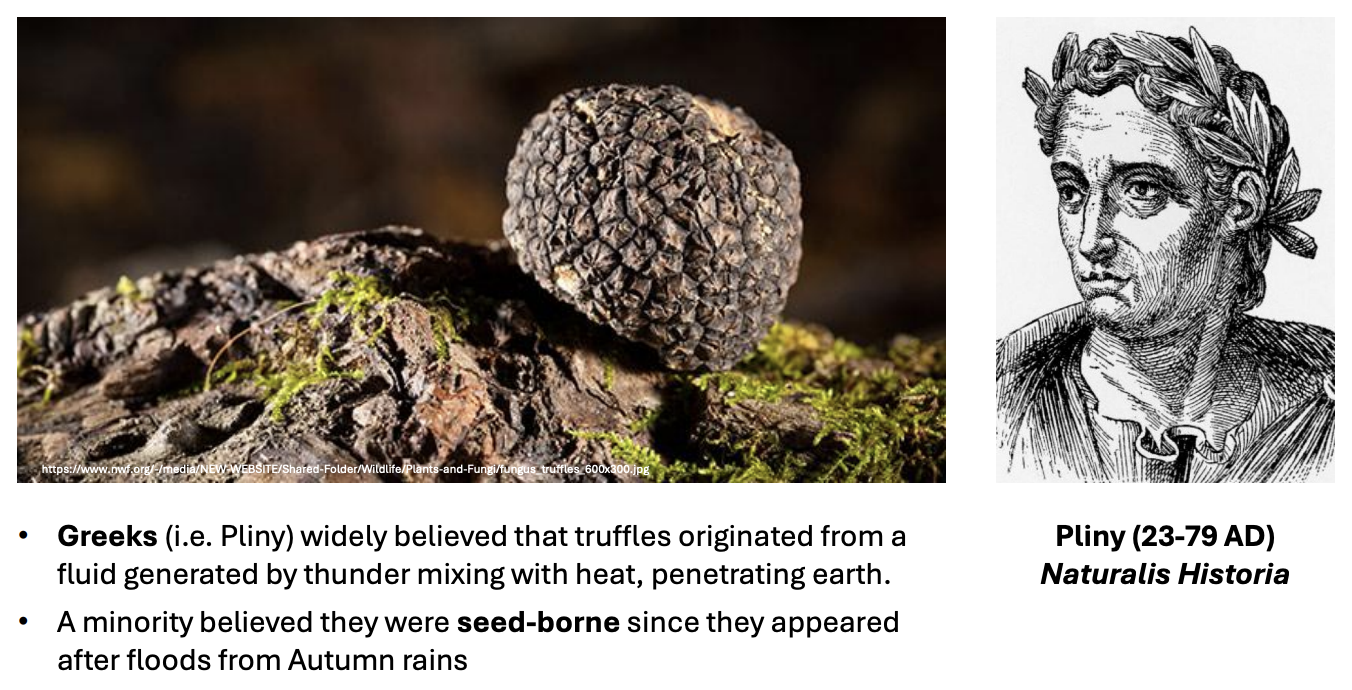
Greeks believed that a mixture of _ resulted in generation of fungi
thm
thunder, heat, moisture (when in reality, fungal spores are triggered by humidity)
T/F: In the Philippines, fungi die out in wet season and bloom back in dry season
FALSE
Fungi generally thrive in wet and humid conditions since fungal spores are activated by humidity, making wet season the ideal time for fungal growth
_, i.e., _ (23-79 AD), widely believed that truffles originated from a fluid generated by thunder mixing with heat, penetrating Earth
Greeks, i.e., Pliny (23-79 AD) Naturalis Historia
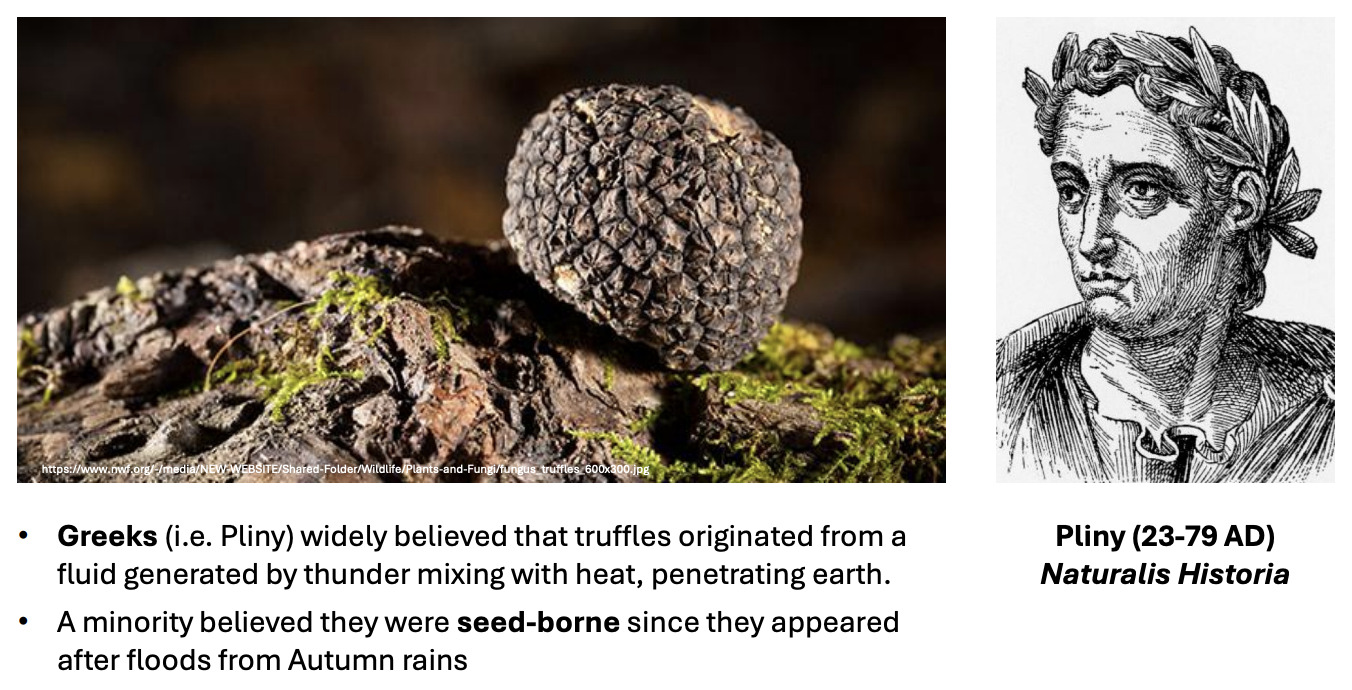
A minority (of Greeks) believed that truffles were _ since they appeared after floods from Autumn rains (but these were too small to be seen)
seedborne

A minority (of Greeks) believed that truffles were seedborne since they appeared _ (important bc this was used later on by a taxonomist to categorize fungi into plants)
after floods from Autumn rains
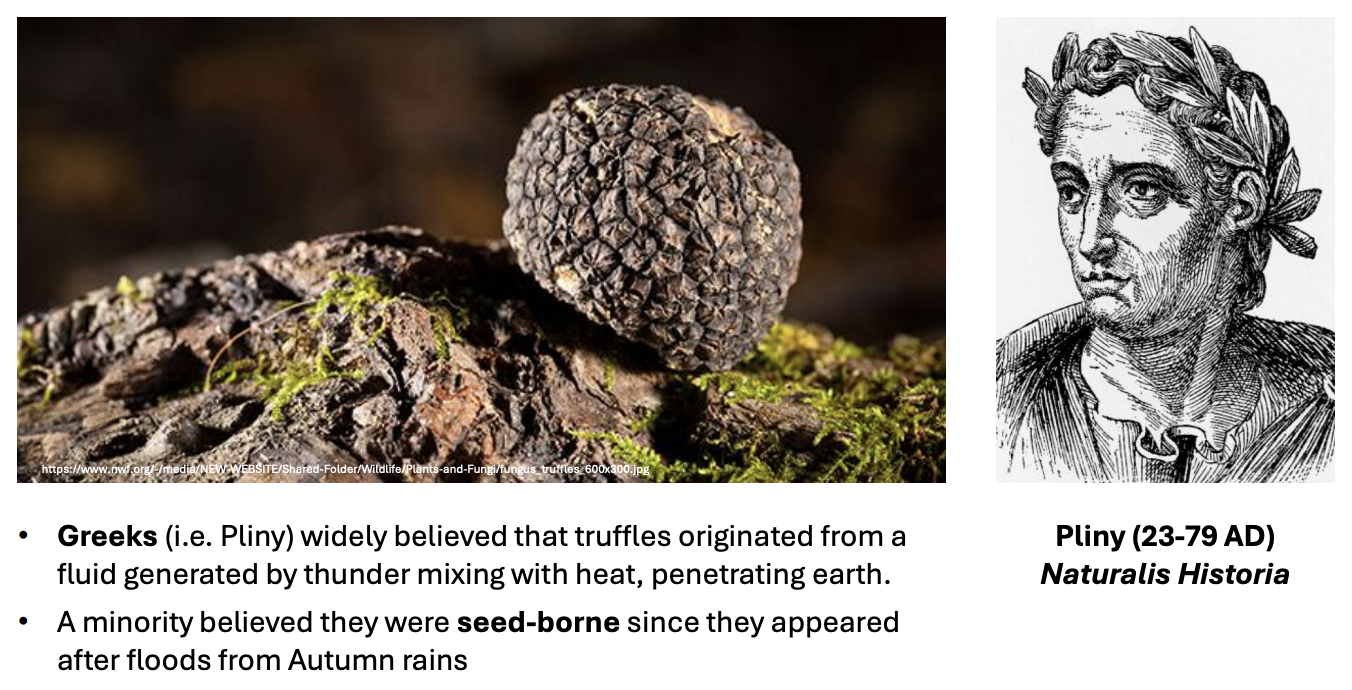
T/F: Fungi is among the most mysterious living things because no one could figure out how they grew
TRUE
Early interest and speculation on fungi centered around _
spores first observed by Giambattista della Porta (1588)

3 competing spontaneous generation theories developed about origin of fungi
Gaspard Bauhin (1560-1624)
“Mushrooms are neither plants, nor roots, flowers, or seeds prfs but only humidity coming from stdo the soil, the trees, dead wood and other rotten elements; their appearance and disappearance last approximately 7 days; they usually appear before thunder and rain”
Friedrich Kasimir Medicus (1736-1808)
“Mushrooms are products of the jelly resulting from organic decay of leaves under the effect of heat and humidity”
Traugott Frenzel (1746-1807)
“The shooting stars pull mushrooms from the earth”
Spontaneous generation theory on fungi origin
Mushrooms are products of the jelly resulting from organic decay of leaves under the effect of heat and humidity
Friedrich Kasimir Medicus (1736-1808)
Spontaneous generation theory on fungi origin
The shooting stars pull mushrooms from the earth
Traugott Frenzel (1746-1807)
Spontaneous generation theory on fungi origin
Mushrooms are neither plants, nor roots, flowers, or seeds, but only humidity coming from the soil, the trees, dead wood and other rotten elements;
their appearance and disappearance last approximately 7 days;
they usually appear before thunder and rain
Gaspard Bauhin (1560-1624)
Giambattista della Porta’s description of fungi (1588)
“We picked up very thin seeds, small and black, hidden in the elongated veins that go from base to cap. The seeds that fall are always fertile and germinate.” [Phytognomonica 1588]
![<p>“We picked up <strong>very thin seeds</strong>, <strong>small and black, hidden in the elongated veins</strong> that go from base to cap. The seeds that fall are <u>always fertile and germinate.”</u> [<em>Phytognomonica</em> 1588]</p>](https://knowt-user-attachments.s3.amazonaws.com/d635efb4-b944-48f3-b2e5-311d3e73f43d.png)
For the longest time, fungi were classified as _
imperfect, deficient plants
5 publications listing fungi as plants in 16th-18th century
De plantis = Andrea Cesalpino (1518-1603)
De mediis naturis in universe = Federico Cesi (1585-1630)
Elements de botanique = Joseph Pitton de Tournefort (1656-1708)
Lobelius = Matthias de l’Obel (1538-1616)
Catalogus plantarum sponte circa Gissam nascentium = Jakob Dillen (1684-1747)
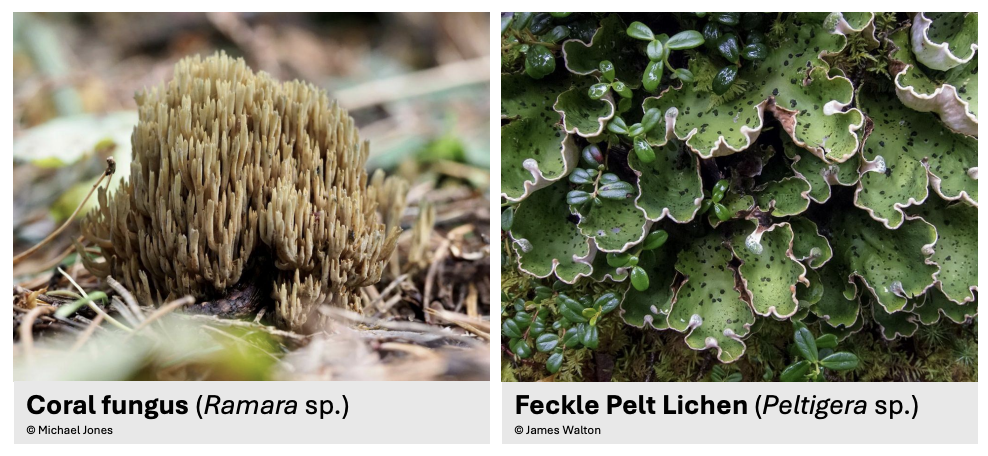
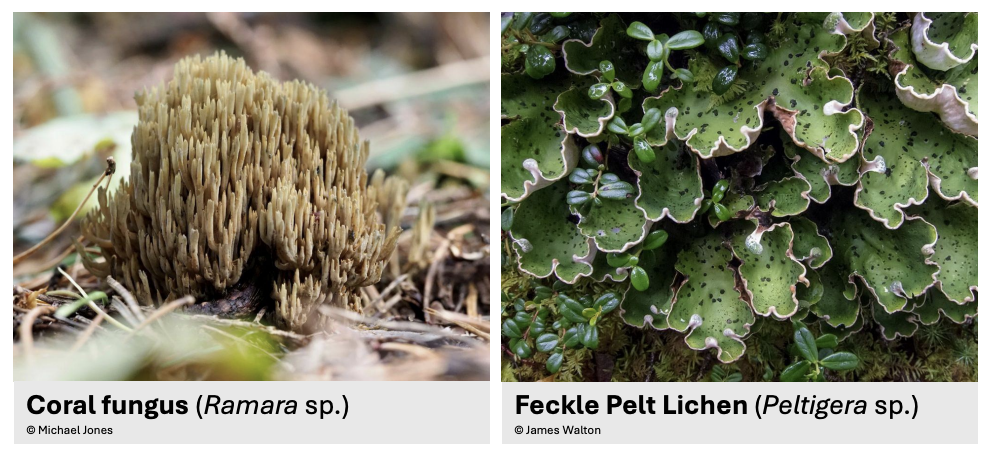
4 common descriptions of Fungi in 16th to 18th century publications
Ramara sp. (Coral fungus), Peltigera sp. (Feckle pelt lichen)
Fungi (and lichens) are in between inanimate objects and plants
“Plants without seeds”
Plantae imperfectae, deficientes, mutilate, inordinate idmi
“Plants for which we know of neither flowers nor seeds”
Historical attempts at classifying fungi began as _
simple endeavors to understand their properties
Classified fungi into edible/poisonous; lasted for 1500 years
Published by Pedanius Dioscorides (1 AD)
Materia Medica
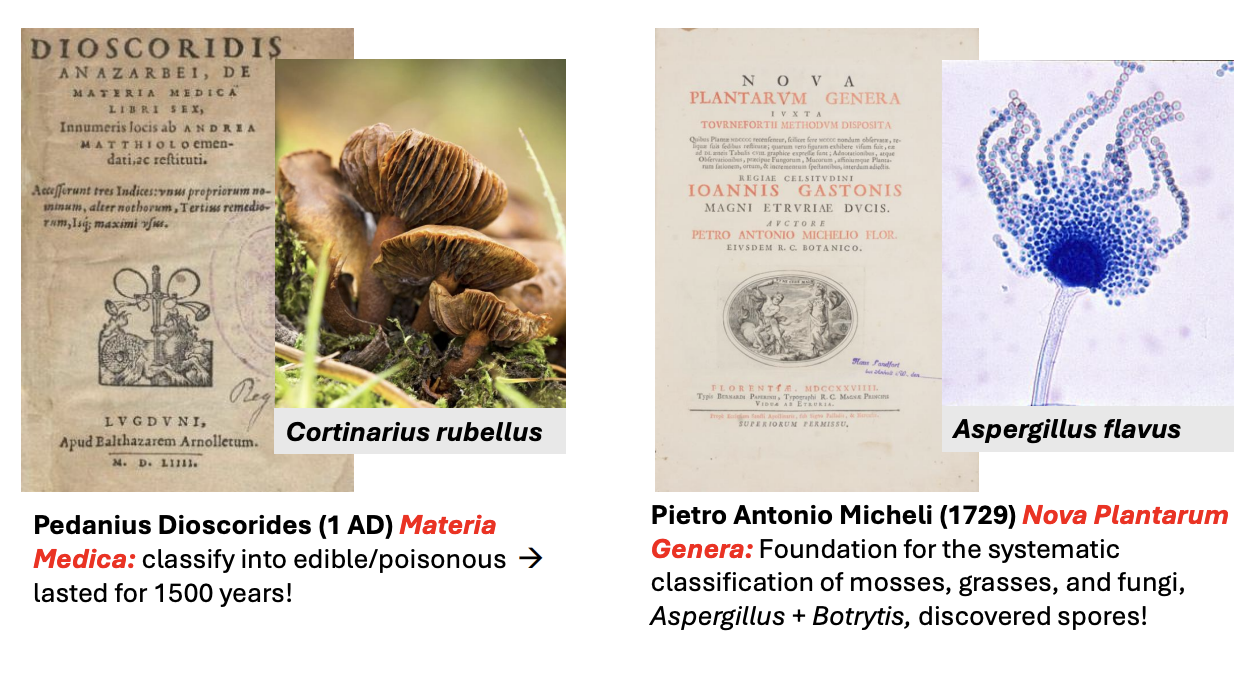
He wrote Materia Medica (1 AD)
Classified fungi into edible/poisonous; lasted for 1500 yrs
Pedanius Dioscorides
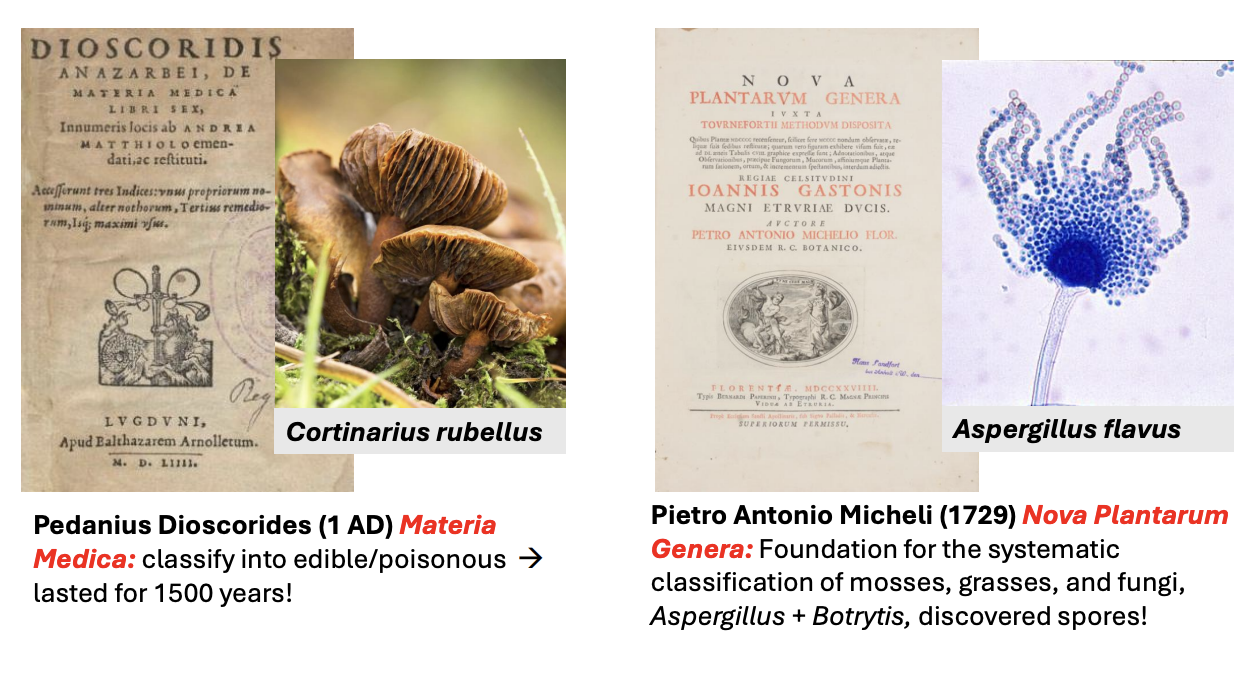
Written by Pietro Antonio Micheli (1729)
Foundation for systematic classification of mosses, grasses, fungi, Aspergillus + Botrytis, discovered spores
Nova Plantarum Genera
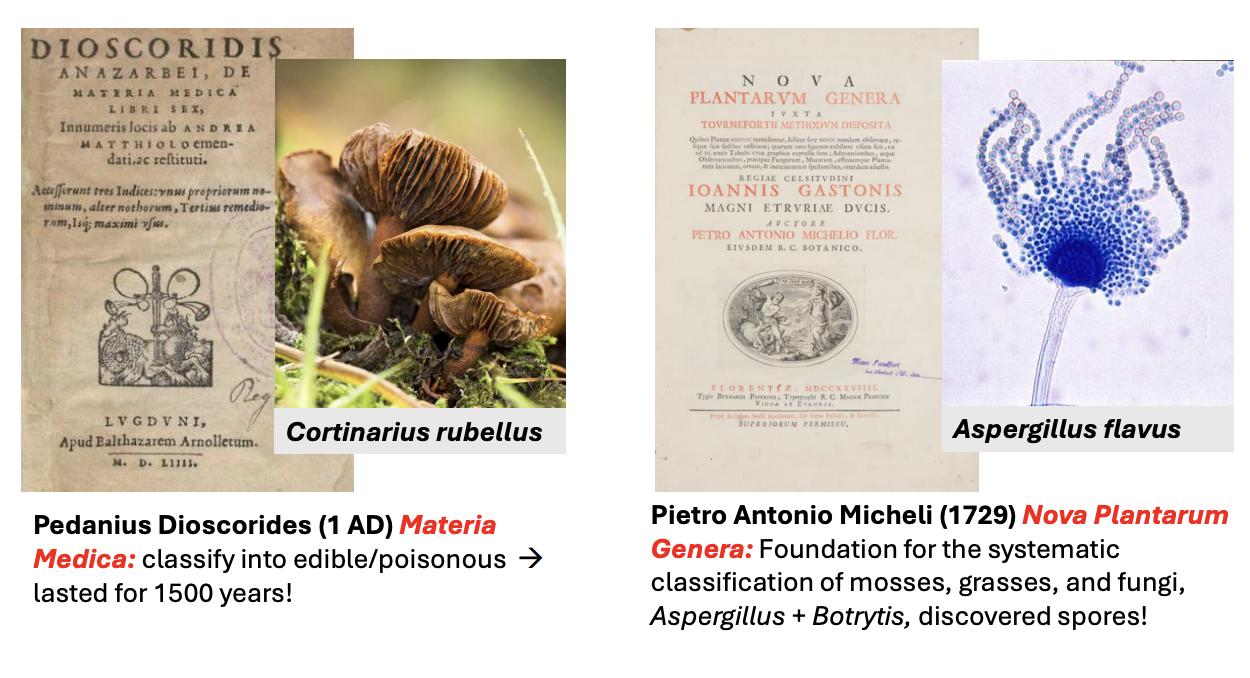
He wrote Nova Plantarum Genera (1729)
Foundation for systematic classification of mosses, grasses, fungi, Aspergillus + Botrytis, discovered spores
Pietro Antonio Micheli
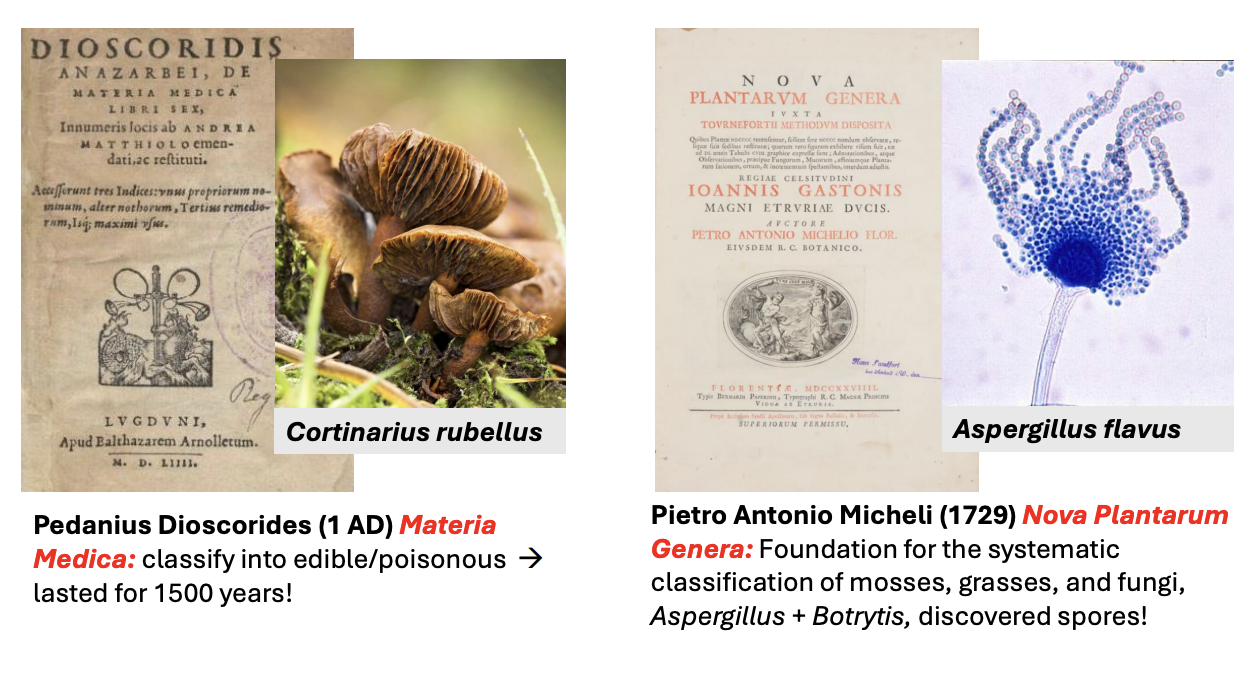
Nova Plantarum Genera by Pietro Antonio Micheli (1729) provided the foundation for _
systematic classification of mosses, grasses, fungi, Aspergillus + Botrytis, discovered spores
Studying _ of fungi hinted at their differences from plants
detailed structures

2 proper mycological illustrations & microscopic descriptions made by Edmond & Charles Tulasne
Fungi hypogaei (1851)
Selecta Fungorum Carpologia (1861-1865)
3 discoveries by Edmond & Charles Tulasne from their illustrations of fungi (i.e., Fungi hypogaei, Selecta Fungorum Carpologia)
pdm
Can produce more than 1 spore type
Different life cycles
Mating between fungi
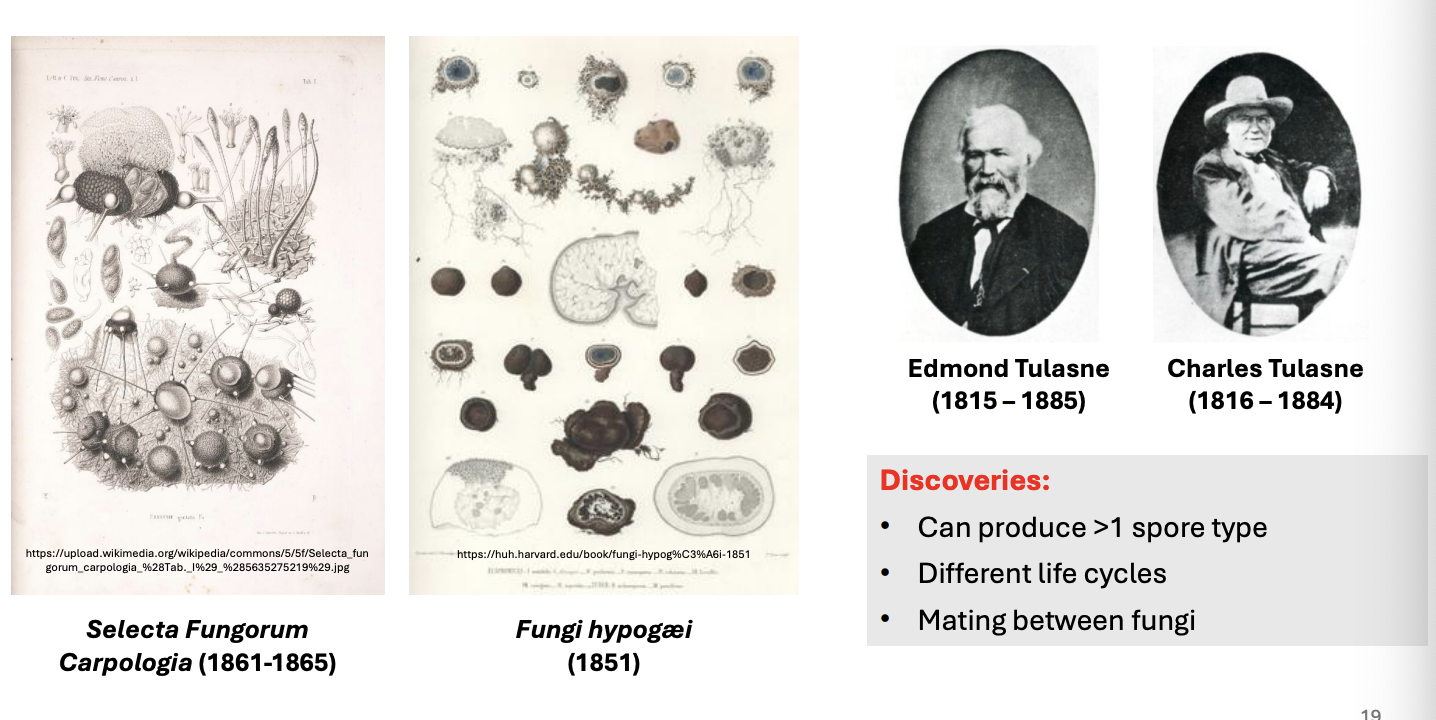
_ separated fungi from plants and other organisms
5-kingdom classification system by Whittaker (1969)
T/F: Whittaker argued in his 5-kingdom classification that Kingdom Fungi is separate not because of its microscopic structure but because of its ecological role
TRUE
Ecological role as multicellular decomposers (have saprophytic, detritivorous nature)
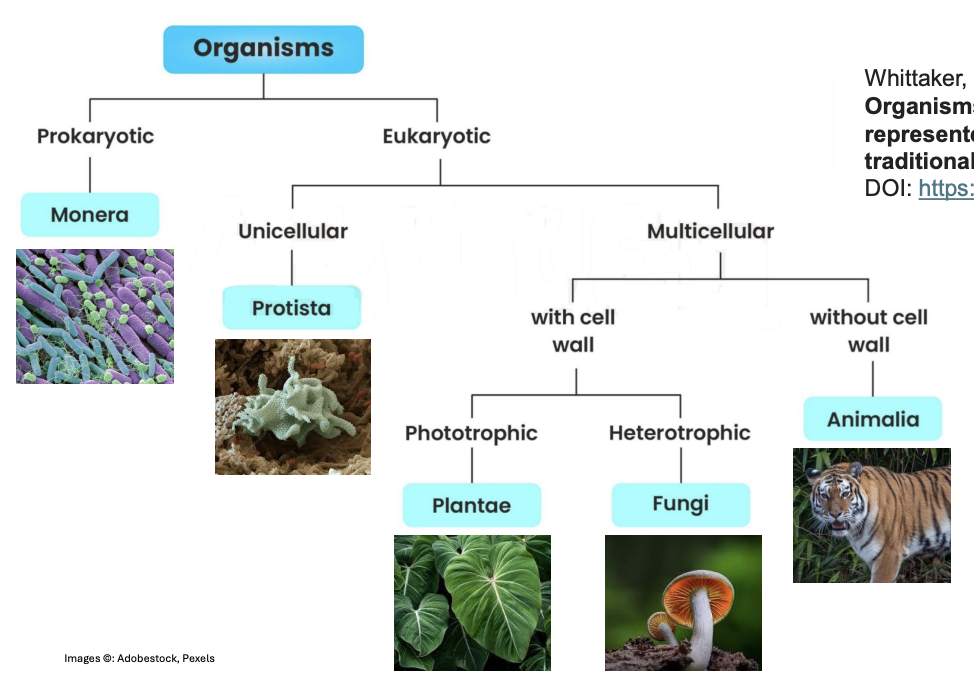
3 corrections in Whittaker’s 5-kingdom classification system
Fungi was separated based on their ecological role as “multicellular decomposers”
Fungi did not have photosynthetic ancestors
Cannot be placed in Plants or Protists
T/F: Fungi was separated in 5-kingdom classification system based on their ecological role as unicellular decomposers
FALSE
Fungi was separated in 5-kingdom classification system based on their ecological role as multicellular decomposers
T/F: Fungi have photosynthetic ancestors
FALSE
They are heterotrophic
T/F: Whittaker’s 5-kingdom classification system posited that Fungi cannot be placed in Plants or Protozoans
FALSE
Whittaker’s 5-kingdom classification system posited that Fungi cannot be placed in Plants or Protists
T/F: Fungi are eukaryotes, can be unicellular/multicellular, have cell walls, and are heterotrophic
TRUE
The traditional division of Kingdom Fungi consists of 5 major phyla established on the basis of _
reproduction or using molecular data
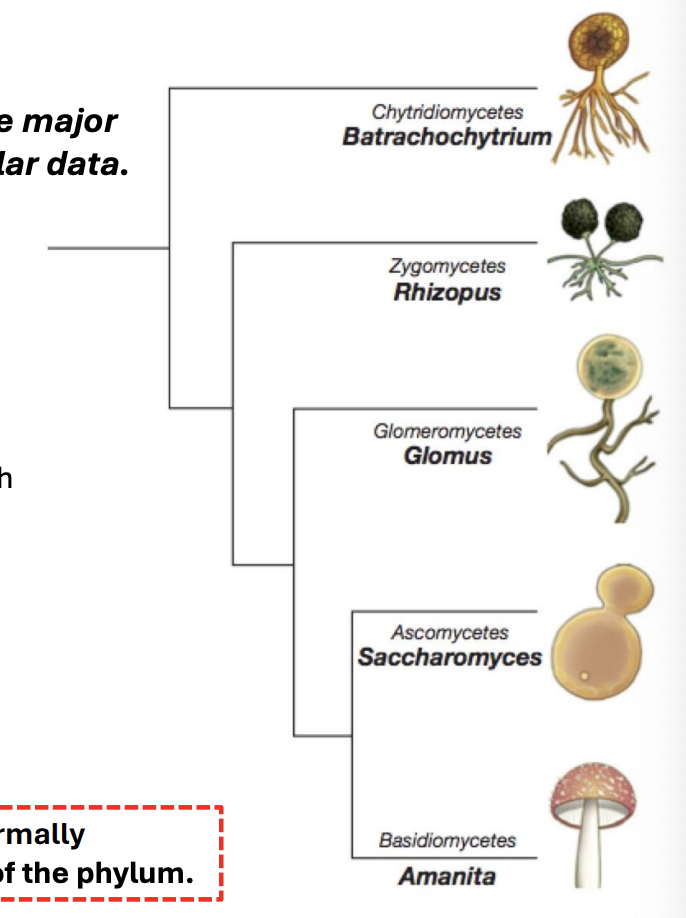
5 major phyla in traditional division of Kingdom Fungi
Chytridiomycota (Chytrids) (e.g., Batrachochytrium dendrobatidis)
Zygomycota (Conjugated fungi/bread molds) (e.g., Rhizopus) → Mucoromycetes, Zoopagomycetes
Glomeromycota (Endomycorrhizae) (e.g., Glomus)
Ascomycota (Sac fungi) (e.g., Saccharomyces)
Basidiomycota (Club fungi) (e.g., Amanita)
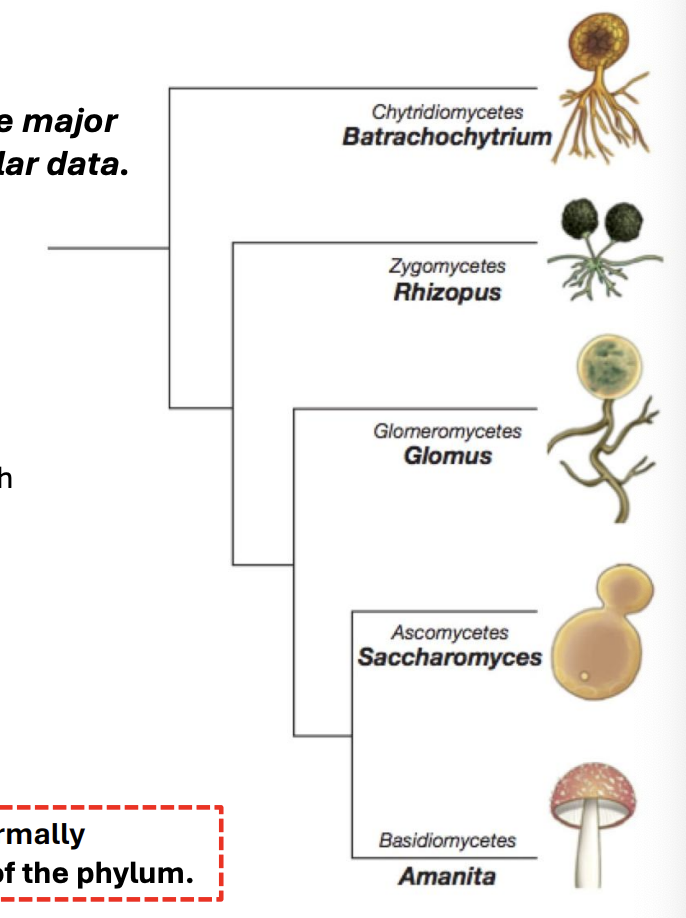
Fungal division/phyla
Most primitive of true fungi (Eumycota)
Mostly unicellular, but some form hyphae
Gametes have flagella (water-dependence)
Chytridiomycota (Chytrids)